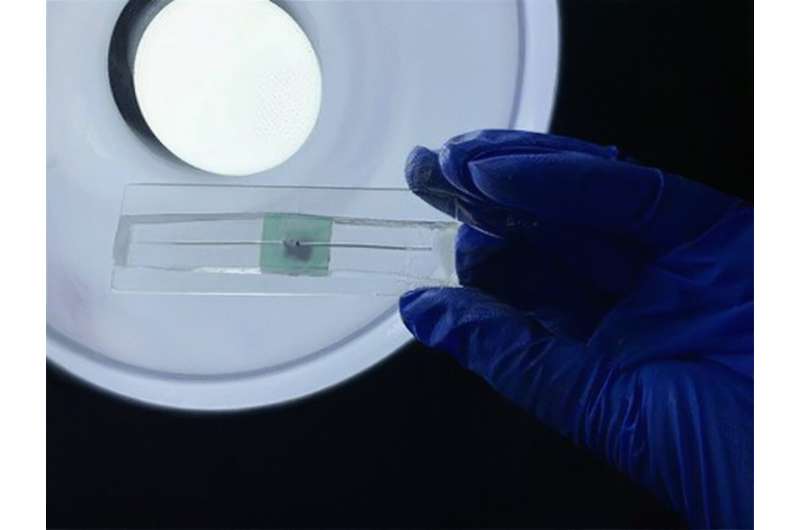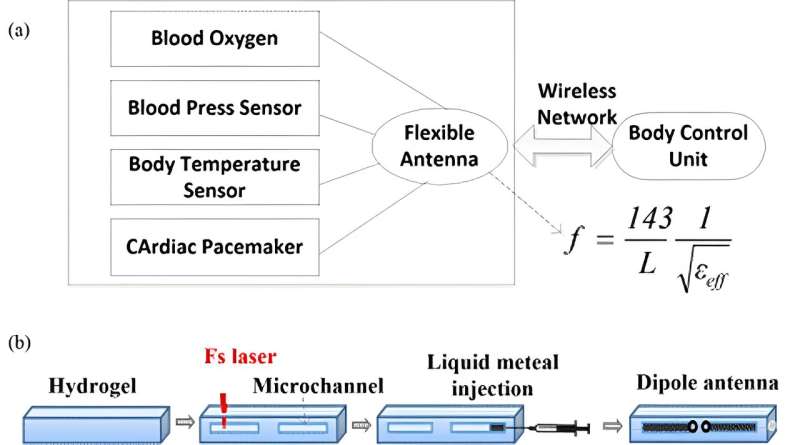This article has been reviewed according to Science X's editorial process and policies. Editors have highlighted the following attributes while ensuring the content's credibility:
fact-checked
peer-reviewed publication
trusted source
proofread
Researchers use liquid metal and laser ablation to create stretchable miniature antennas

Researchers have developed a new method for making tiny stretchable antennas from a hydrogel and liquid metal. The antennas could be used in wearable and flexible wireless electronic devices to provide a link between the device and external systems for power delivery, data processing and communication.
"Using our new fabrication approach, we demonstrated that the length of a liquid metal antenna can be cut in half," said Tao Chen from Xi'an Jiaotong University in China. "This may help downsize wearable devices used for health monitoring, human activity monitoring, wearable computing and other applications, making them more compact and comfortable."
In the journal Optics Express, the researchers describe their new technique, which involves injecting eutectic gallium-indium—a metal alloy that is a liquid at room temperature—into a microchannel created with a single-step femtosecond-laser ablation process. They used this method to create an antenna measuring 24 mm × 0.6 mm × 0.2 mm embedded into a 70 mm × 12 mm× 7 mm hydrogel slab.
"Stretchable and flexible antennas could be useful for wearable medical devices that monitor temperature, blood pressure and blood oxygen, for example," said Chen. "Separate mobile devices could connect to a larger control unit via the flexible antennas—which would transfer data and other communications—forming a wireless body-area network. Since the resonance frequencies of the flexible antennas vary with applied strain, they could potentially also be used as a wearable motion sensor."
A more flexible metal
The work grew out of previous research, performed in cooperation with Jian Hu from King Abdullah University of Science and Technology in Saudi Arabia, in which the investigators developed a way to fabricate 3D silver structures embedded in hydrogel for strain sensing using femtosecond laser ablation (cooperated with Prof. Jian Hu).
"The silver structures exhibited poor stretchability because they were very fragile," said Chen. "Using liquid metal instead of a solid metal structure not only makes the metal easier for filling the hydrogel microchannel but increases its ability to stretch."
To make a liquid metal dipole antenna—the simplest and most widely used type of antenna—the researchers scanned a femtosecond laser to form a pair of symmetrical microchannels inside a hydrogel without harming the surface. The laser's short pulse duration produces a high peak power that allows ablation of transparent material via nonlinear optical effects like multiphoton absorption, which ensures that ablation only takes place at the precise focal point for the laser.

They then injected the liquid metal into the microchannels, forming a hydrogel-embedded wire that can be used as an antenna.
They selected hydrogel as a substrate because it has more favorable dielectric properties compared to polydimethylsiloxane (PDMS) and other conventional polymer substrates, allowing the length of the antenna to be reduced by half. Hydrogel-based devices can also be stretched to almost double their original length.
However, hydrogel-based liquid metal devices are typically fabricated using a laser to engrave grooves on the top surface, filling them with liquid metal and then bonding the patterned substrate with an unengraved substrate.
"Using our method, the microchannel can be embedded in hydrogel using a single fabrication step with no need for layer bonding," said Chen. "In addition, 3D microchannels as well as liquid metal structures can be easily formed by 3D scanning the femtosecond laser, which makes it possible to fabricate 2D or 3D flexible antennas with complicated structures for performance and function enhancement."
Making a stretchable antenna
To demonstrate the new fabrication approach, the researchers prepared stretchable dipole antennas and measured their reflection coefficients at different frequencies. These experiments showed that the pure hydrogel reflects almost all the incident electromagnetic wave energy, while the liquid metal dipole antenna embedded in hydrogel radiates most of the incident electromagnetic wave effectively into free space, with less than 10% reflected at the resonance frequency.
They also showed that by varying the applied strain from 0 to 48%, the resonant frequency of the antenna can be tuned from 770.3 MHz to 927.0 MHz.
The researchers are now working to improve the sealing technique used on the laser-induced microchannels to increase the strength of the flexible stretchable antenna and the threshold strain of liquid metal leaking. They also plan to explore how this new approach could be applied for developing fully flexible multidimensional strain and pressure sensors with complicated 2D or 3D structures.
More information: Pingping Zhao et al, Fabrication of a flexible stretchable hydrogel-based antenna using a femtosecond laser for miniaturization, Optics Express (2023). DOI: 10.1364/OE.496360
Journal information: Optics Express
Provided by Optica




















